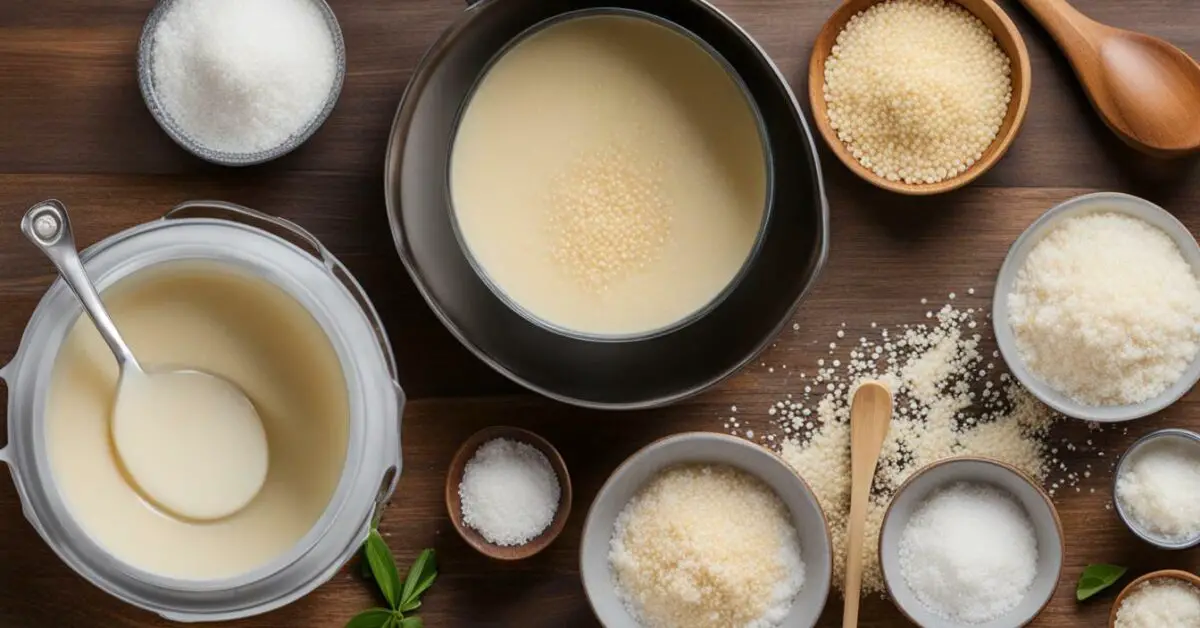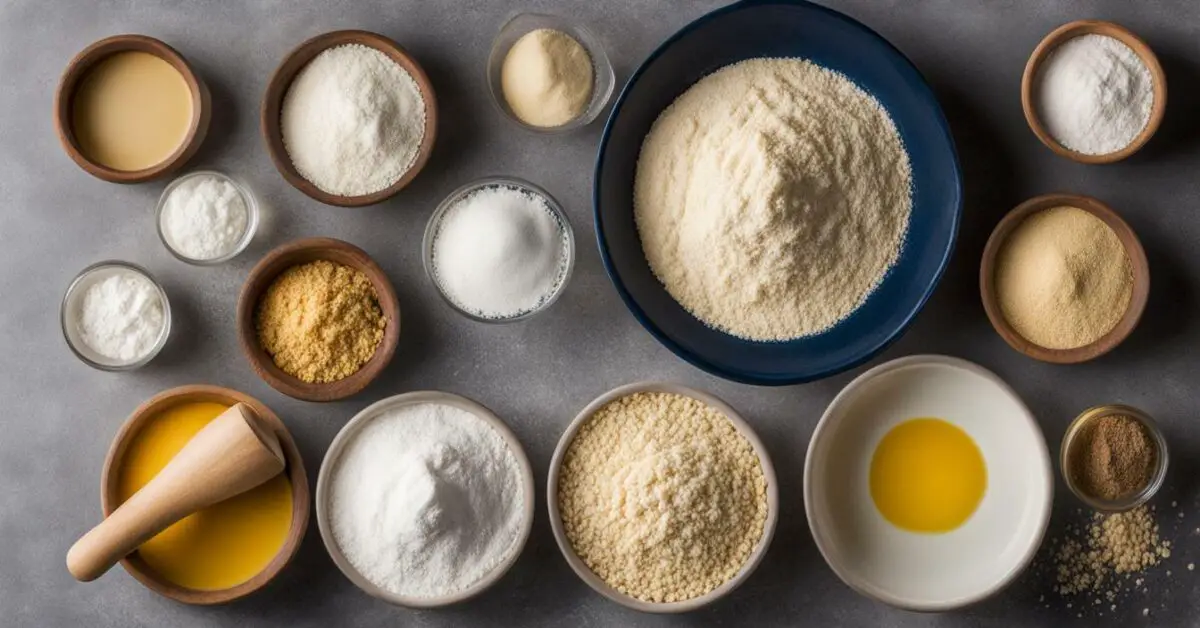
This post may contain affiliate links. Please read my disclosure for more information.
Are you looking for alternatives to cornstarch in your pavlova recipe? Here are the 5 best substitutes that will help you achieve a similar texture and consistency.
Key Takeaways:
- Tapioca starch can be used in a 2:1 ratio with cornstarch.
- All-purpose flour can be substituted for cornstarch in a 2:1 ratio.
- Rice flour works well as a substitute and can be used in a 2:1 ratio.
- Potato starch can be used in a 1:1 ratio with cornstarch.
- Arrowroot powder can be used in the same amount as cornstarch.
Tapioca Starch: A Perfect Substitute for Cornstarch in Pavlova
One of the best substitutes for cornstarch in pavlova is tapioca starch. It provides a similar thickening effect and helps achieve that signature texture that makes pavlova so delightful. To use tapioca starch as a substitute, simply replace 1 tablespoon of cornstarch with 2 tablespoons of tapioca starch in your pavlova recipe.
Tapioca starch is derived from the cassava plant and is known for its ability to create a light and crispy pavlova shell. When mixed with the other ingredients, it helps bind everything together, resulting in a delicious and airy dessert.
If you’re looking for an alternative to cornstarch in your pavlova recipe, tapioca starch is a great choice. Give it a try and elevate your pavlova baking skills to new heights!
Table 1: Substituting Tapioca Starch for Cornstarch in Pavlova
| Cornstarch | Tapioca Starch |
|---|---|
| 1 tablespoon | 2 tablespoons |
Keep in mind that these measurements are general guidelines, and you may need to adjust them slightly based on your specific recipe. However, using tapioca starch as a substitute for cornstarch in pavlova is a reliable and delicious choice. Enjoy your homemade pavlova with the perfect texture and taste!
All-Purpose Flour: A Versatile Substitute for Cornstarch in Pavlova
If you don’t have cornstarch on hand, you can use all-purpose flour as a substitute in your pavlova recipe. Simply substitute 2 tablespoons of all-purpose flour for every 1 tablespoon of cornstarch. All-purpose flour is a pantry staple that most home bakers have readily available, making it a convenient option for those looking to make pavlova without cornstarch.
While all-purpose flour may slightly alter the texture of your pavlova, it still yields a delicious result. The flour adds a bit more structure to the meringue, resulting in a slightly denser consistency, but the pavlova will still be light and airy.
If you’re worried about the flavor, rest assured that the all-purpose flour won’t overpower the delicate taste of the pavlova. It blends seamlessly with the other ingredients, allowing the flavors of the pavlova to shine through.
| Cornstarch | All-Purpose Flour |
|---|---|
| 1 tablespoon | 2 tablespoons |
Next time you find yourself without cornstarch, don’t let it stop you from making a delicious pavlova. Grab that bag of all-purpose flour from your pantry and confidently substitute it in your recipe. With 2 tablespoons of all-purpose flour for every tablespoon of cornstarch, you’ll still be able to enjoy a pavlova with a delightful texture and taste.
Rice Flour: A Gluten-Free Alternative
For a gluten-free option, try using rice flour as a substitute for cornstarch in your pavlova recipe. Use 2 tablespoons of rice flour for every 1 tablespoon of cornstarch. Rice flour works well in pavlova recipes and can help you achieve a similar texture and consistency without the use of cornstarch.
Rice flour is a fine, powdery substance made from finely milled rice grains. It is commonly used in gluten-free baking and lends a light and delicate texture to desserts. When used as a substitute for cornstarch in pavlova, rice flour helps create a fluffy and airy meringue with a crisp exterior.
When incorporating rice flour into your pavlova recipe, there are a few things to keep in mind. Firstly, make sure to measure the rice flour accurately using tablespoons or a kitchen scale. Secondly, be aware that rice flour may absorb more moisture than cornstarch, so you may need to adjust the liquid ingredients slightly to maintain the desired consistency.
| Substitute | Measurement |
|---|---|
| Rice Flour | 2 tablespoons |
| Cornstarch | 1 tablespoon |
With rice flour as a substitute, you can confidently bake a delicious pavlova that meets your dietary needs and preferences. Experiment with different flavors and toppings to create a pavlova masterpiece that will impress your friends and family.
Potato Starch: Another Substitute for Cornstarch in Pavlova
Another substitute for cornstarch in pavlova is potato starch. You can use it in the same amount as cornstarch in your recipe to achieve a similar result. Potato starch is a versatile alternative that helps thicken the mixture and contributes to a crispy exterior.
To use potato starch as a substitute, simply replace the cornstarch with an equal amount of potato starch. For example, if your pavlova recipe calls for 1 tablespoon of cornstarch, you would use 1 tablespoon of potato starch instead. This ratio ensures that the texture and consistency of your pavlova remain intact.
Potato starch is known for its ability to provide a light and airy texture to baked goods. When used in pavlova recipes, it helps create a delicate and fluffy dessert that is sure to impress. Whether you have a cornstarch allergy or simply want to try something different, potato starch is an excellent choice.
So, next time you find yourself without cornstarch for your pavlova, reach for potato starch instead. With its similar thickening properties and contribution to the crispy exterior, potato starch will help you achieve a delicious pavlova that is just as delightful as the original recipe.
| Substitute | Measurement |
|---|---|
| Potato Starch | Equal amount as cornstarch |
Arrowroot Powder: A Plant-Based Substitute for Cornstarch in Pavlova
If you’re looking for a plant-based substitute for cornstarch in pavlova, arrowroot powder is a great option. Use it in the same amount as cornstarch in your recipe. Arrowroot powder is a natural starch that works well as a thickening agent and provides a smooth texture to your pavlova.
To use arrowroot powder as a substitute, simply replace the amount of cornstarch called for in your recipe with an equal amount of arrowroot powder. For example, if your pavlova recipe calls for 1 tablespoon of cornstarch, you can use 1 tablespoon of arrowroot powder instead.
One of the advantages of using arrowroot powder is that it is gluten-free and easily digested. This makes it a suitable option for those with gluten sensitivities or dietary restrictions. The light and airy texture it contributes to pavlova will have your guests raving about your baking skills.
Table: Comparison of Substitutes for Cornstarch in Pavlova
| Substitute | Measurement Conversion | Texture |
|---|---|---|
| Tapioca Starch | 2 tbsp per 1 tbsp cornstarch | Similar to cornstarch |
| All-Purpose Flour | 2 tbsp per 1 tbsp cornstarch | Slightly different texture |
| Rice Flour | 2 tbsp per 1 tbsp cornstarch | Light and airy |
| Potato Starch | 1:1 ratio with cornstarch | Crispy exterior |
| Arrowroot Powder | Same amount as cornstarch | Smooth texture |
By using these substitutes, you can still achieve a delicious pavlova without cornstarch. Whether you choose the tapioca starch, all-purpose flour, rice flour, potato starch, or arrowroot powder, each alternative offers its own unique qualities that will enhance your pavlova baking experience. So go ahead and experiment with these substitutes to find the perfect one for your next pavlova creation.
Conclusion
With these top substitutes for cornstarch in pavlova, you can confidently create delicious pavlova desserts even without using cornstarch. Explore these alternatives and experiment with different flavors to elevate your pavlova baking skills.
Tapioca starch is a popular option that provides a similar thickening effect and helps give pavlova its signature texture. Substitute 2 tablespoons of tapioca starch for every 1 tablespoon of cornstarch in the recipe.
All-purpose flour is another viable substitute, although it may slightly alter the texture. To replace cornstarch, use 2 tablespoons of all-purpose flour for every 1 tablespoon of cornstarch.
Rice flour is an excellent alternative that creates a light and airy pavlova with a delicate texture. Use 2 tablespoons of rice flour for every 1 tablespoon of cornstarch.
Potato starch can be used in a 1:1 ratio with cornstarch in pavlova recipes. It helps thicken the mixture and contributes to a crispy exterior.
Lastly, arrowroot powder is a natural starch that works well as a substitute for cornstarch in pavlova. Use the same amount of arrowroot powder as you would cornstarch in the recipe.
With these substitutes, you can still achieve a similar texture and consistency in your pavlova, ensuring that cornstarch is no longer a barrier to creating delectable desserts.
FAQ
What are the best substitutes for cornstarch in pavlova?
The best substitutes for cornstarch in pavlova are tapioca starch, all-purpose flour, rice flour, potato starch, and arrowroot powder.
How much tapioca starch should I use as a substitute for cornstarch in pavlova?
For every 1 tablespoon of cornstarch, use 2 tablespoons of tapioca starch in your pavlova recipe.
Can I use all-purpose flour instead of cornstarch in pavlova?
Yes, you can substitute 2 tablespoons of all-purpose flour for every 1 tablespoon of cornstarch in your pavlova recipe.
How much rice flour should I use as a substitute for cornstarch in pavlova?
Use 2 tablespoons of rice flour for every 1 tablespoon of cornstarch in your pavlova recipe.
Can I use potato starch as a substitute for cornstarch in pavlova?
Yes, you can use potato starch in a 1:1 ratio with cornstarch in your pavlova recipe.
How much arrowroot powder should I use instead of cornstarch in pavlova?
Use the same amount of arrowroot powder as you would cornstarch in your pavlova recipe.
Can I achieve a similar texture and consistency in pavlova without cornstarch?
Yes, using these substitutes for cornstarch in pavlova will help you achieve a similar texture and consistency without cornstarch.


